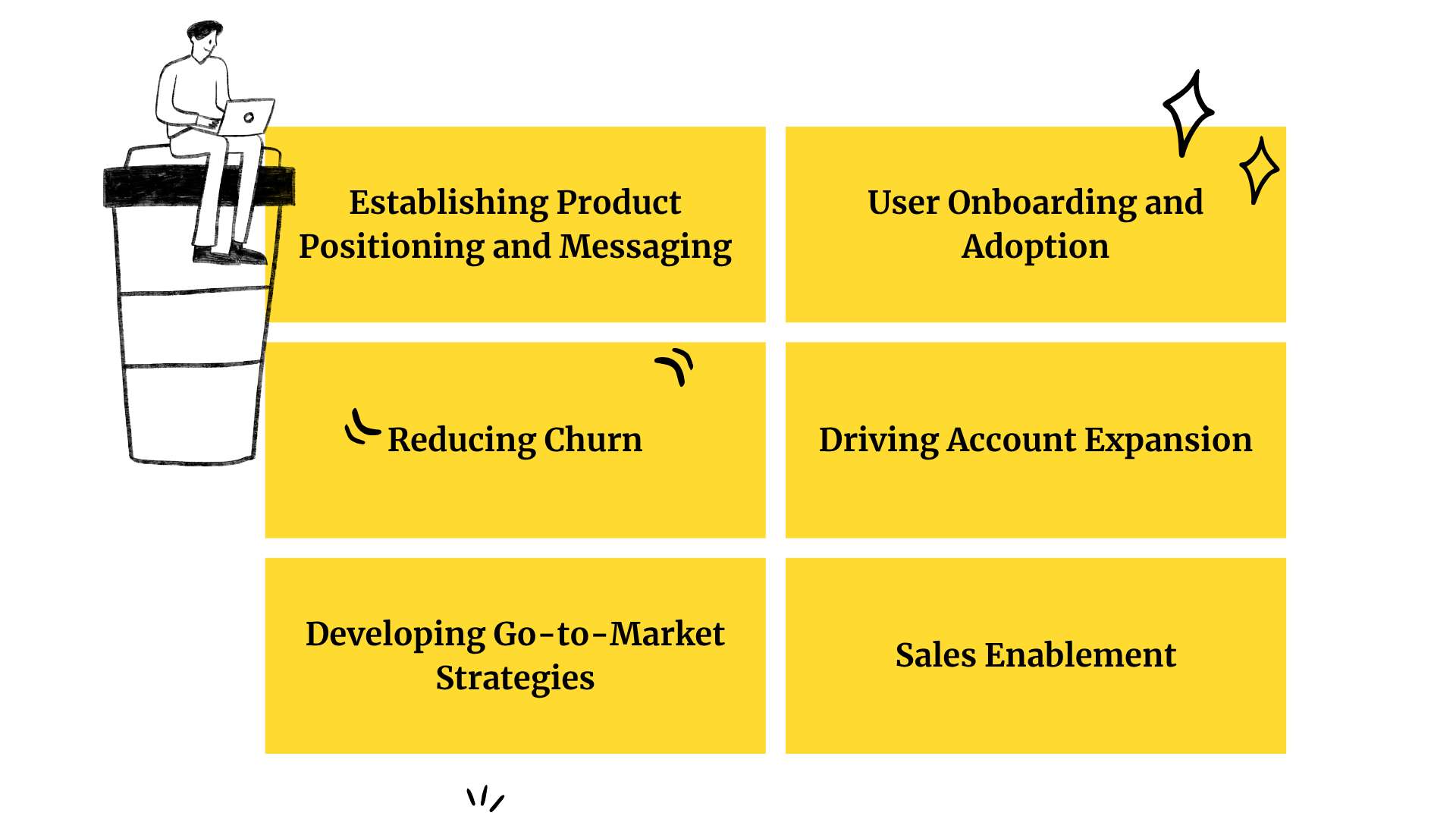The SaaS world moves fast. Blink and your leads ghost you.
Let’s fix that.
We’ll help you go from “What do you do again?” to “Where do I sign?” The playbook even your product team will thank you for. Yes, really.
Welcome to the jungle! The B2B SaaS jungle! However, fear not, brave marketer! You are not here to get lost. You are here to win.
This isn’t just another “growth hack” checklist stuffed with jargon-flavored fluff. This is your complete guide to successful B2B SaaS product marketing.
Filled with genuine tactics, useful advice, and straightforward ideas that convert new members into ardent supporters and churn them into devoted followers.
Let’s now explore the entire strategy for successful B2B SaaS product marketing!
At A Glance: The Complete Playbook for B2B SaaS Product Marketing Success
| 1. Creating a Winning B2B SaaS Product Positioning Strategy |
| 2. Building a Scalable Go-To-Market (GTM) Strategy |
| 3. Messaging and Content Strategy That Converts |
| 4. Product Marketing Metrics and KPIs to Track |
| 5. Aligning Product Marketing with Sales and Customer Success |
| 6. Product Launches: How to Plan, Execute, and Measure Success |
Relatable Read: The Ultimate SaaS SEO Guide
Understanding the Role of Product Marketing in B2B SaaS
In B2B SaaS, product marketing is essential in bringing the product to market.
This helps to make sure that it:
- Satisfies client demands
- Promotes adoption, retention, and revenue development
6 Key Responsibilities of a SaaS Product Marketer
1. Establishing Product Positioning and Messaging: Develop precise and focused positioning. Make sure it communicates the product’s special value to the appropriate market.
2. User Onboarding and Adoption: Create ongoing onboarding procedures to
- Boost feature adoption
- Assist users in realizing the value of the product
3. Reducing Churn: Identify areas of friction and improve messaging and user experience to solve them to keep consumers.
4. Driving Account Expansion: Using tailored communications to identify upsell and cross-sell possibilities within current client accounts.
5. Developing Go-to-Market Strategies: Organize and carry out campaigns and product launches. As it helps to create demand and coordinate the efforts of the product, marketing, and sales teams.
6. Sales Enablement: Sales enablement is giving sales teams the resources, messaging, and instruction they need to successfully convey the value of a product and dispel objections.
Comparison Between Product Marketing, Growth, and Brand Marketing
| Aspect | Product Marketing | Growth Marketing | Brand Marketing |
| Purpose | Product positioning, message, acceptance, and value | Driving rapid user acquisition, activation, and retention via data | Building long-term emotional connection and trust with the brand |
| Focus | Customer needs and product fit | Data-driven scaling and experimentation | Brand recognition, loyalty, and identity |
| Key Activities | Market research, messaging, onboarding, sales enablement | A/B testing, funnel optimization, multi-channel campaigns | Brand storytelling, campaigns, and consistency across channels |
| Goal | Product adoption, revenue, and retention | Quick growth in users and revenue | Long-term equity and customer loyalty |
| Interaction with Customers | Deep user insights to tailor messaging and product usage | Analytical and tactical execution to optimize the customer journey | Emotional engagement and building brand perception |
Relatable Read: HOW TO BUILD A KILLER SALES FUNNEL
How Does Product Marketing Drive Revenue and Retention?
Revenue Growth: Product marketing creates demand and speeds up sales by:
- Crafting compelling positioning
- Messaging that appeals to target personas
Enhancing Customer Acquisition: You can lower acquisition costs and boost sign-up rates by providing a clear product value through:
- Free trials
- Onboarding
- Website experiences
Enhancing Retention: You can increase client loyalty by:
- Ongoing training via secondary and tertiary onboarding
- Feature uptake
- User interaction
Driving Account Expansion: By segmenting active users and presenting tailored offers, product marketing finds upselling and cross-selling opportunities. As a result, it increases average revenue per user.
Marketing and Sales Alignment: Working closely with sales teams guarantees that the value proposition of the product is communicated clearly. To reduce sales cycles and improve close ratios.
1. Creating a Winning B2B SaaS Product Positioning Strategy
Some essential steps in developing a successful B2B SaaS product positioning strategy are:
- Creating a compelling value proposition
- Using successful positioning frameworks
- Establishing a scalable go-to-market strategy with team alignment and launch planning
- Defining your ideal customer profile
How to Define Your Ideal Customer Profile (ICP) and Buyer Personas?
An ICP is a detailed description of the perfect customer that fits well with your product. It tends to have high retention, profitability, and satisfaction.
Define your ideal customer profile and buyer personas through:
- Customer segmentation
- Data-driven strategies
- Interviews and feedback
Create a Compelling Value Proposition
- Customer-Centric: Put your attention on resolving particular issues for customers. Provide observable advantages like cost reductions or increased productivity.
- Clarity and Simplicity: Use straightforward language that stays away from jargon to connect with prospects right away. Keep it brief and benefit-focused.
- Differentiate: Stress the emotional and utilitarian advantages of your product to differentiate it from rivals.
- Test and Improve: Continuously run A/B tests on your messages and gather feedback to improve your value proposition and increase conversion.
2. Building a Scalable Go-To-Market (GTM) Strategy
A GTM strategy is a thorough plan that coordinates product launch, marketing, sales, and customer success. It helps to draw in and keep customers while increasing revenue.
Feature updates concentrate on particular benefits to a targeted market with suitable scaling. New product releases need a comprehensive strategy encompassing channels, messaging, and discovery.
To provide a flawless customer experience, make sure all teams share common objectives, KPIs, and channels of communication.
Moreover, to organize activities, use structured templates that address:
- Positioning
- Campaign planning
- Cross-functional alignment
- Pre-launch research
- Post-launch analysis
3. Messaging and Content Strategy That Converts
Create a message that speaks to the distinct goals, difficulties, behaviors, and motivations of each persona. Use customer language from reviews or interviews to provide relatability and authenticity to your content.
Sort, simplify, and choose messages so that partners, marketing, and sales may easily utilize and customize them for their target audience.
Customized content for social media personas increases relevance and empathy. It raises engagement and returns on investment.
Relatable Read: Content Marketing Strategies for B2B SaaS Companies that Truly Works
Key Content Assets
One-Pagers: Brief, benefit-oriented publications condense complex information into a brief, captivating image for a variety of audiences. For instance, sales, investors, and customers.
Sales Decks: Sales decks are graphic presentations that tell an engaging tale. They:
- Highlight the benefits of the product
- Employ social proof
- Conclude with powerful calls to action
Battle Cards: They are succinct competitive summaries. They include
- Important competitor and product features
- Scripts for overcoming objections
- Proof points
They are intended to be quickly consulted during sales talks.
Demo Scripts: Demo scripts are structured screenplays with interactive and narrative components. They are intended to captivate, prove value, and convert prospects.
4. Product Marketing Metrics and KPIs to Track
Key Metrics:
- Product Adoption: Monitors user uptake and engagement using metrics. Such as retention, time-to-value, activation, adoption rate, and feature utilization.
- Net Promoter Score (NPS): The Net Promoter Score (NPS) divides customers into promoters, passives, and detractors. Based on a customer’s propensity to suggest. It normally ranges from -100 to +100.
- Churn: A measure of the percentage of customers or accounts that are lost over time. It is crucial to track revenue, health, and retention. There are several types of churn. These include dollar churn, gross and net dollar churn, and customer (logo) churn.
- Customer Acquisition Cost (CAC): The average cost of sales and marketing to bring in a new client. It is used to determine ROI and create budgets.
Relatable Read: 14 SEO Strategies to Grow Enterprise Saas Companies in 2025
5. Aligning Product Marketing with Sales and Customer Success
Product marketing should be carefully matched with sales and customer success. Develop a cohesive strategy that increases revenue and improves customer satisfaction.
Give sales teams specialized tools and messaging that representatives are prepared to interact with prospects efficiently and reduce sales cycles.
Cooperation with customer success teams:
- Lowers churn
- Promotes customer engagement
- Helps remove adoption barriers
Moreover, creating strong feedback loops across marketing makes continuous improvement possible.
Enabling the Sales Team with the Right Tools and Messaging
Sales enablement solutions increase productivity by giving sales teams access to capabilities like
- Content management
- Training communication
- Analytics
- CRM connection
Moreover, sales representatives may provide meaningful and individualized communications to prospects through a variety of channels. That too, with the backing of sales enablement technologies and effective messaging.
Collaborating with Customer Success to Improve Adoption and Reduce Churn
To boost product adoption, product and customer success teams need to collaborate closely.
Customer success teams actively engage customers throughout their journey to improve retention and reduce churn. They also foresee problems and offer pertinent resources.
Moreover, collaboration across departments about customer data and objectives
improves both corporate growth and the overall customer experience.
6. Product Launches: How to Plan, Execute, and Measure Success
Pre-launch Planning
- To get teams in agreement on product positioning and launch strategy, conduct internal communications.
- Solicit input from beta users before the product is fully released.
- Create go-to-market strategies and clear messaging based on strategic positioning and research.
Launch-day Tactics
- To raise awareness and pique client interest, use well-planned email campaigns, press releases, webinars, and demos.
- Launch materials and enablement resources for productive customer interactions can help boost sales and customer success.
Post-launch Optimization
- Use feedback loops to prioritize product versions, record user experiences, and pinpoint problems.
- To evaluate success, track important launch indicators pertaining to adoption, engagement, and revenue effect.
- To maintain momentum and raise user engagement, make adjustments to marketing and product strategies in light of the information acquired.
Let’s Get Into The Next Level B2B Saas Product Marketing!
Let’s be real. Even the best playbooks need a quarterback. That’s where MonsterClaw steps in.
We are the growth engine your SaaS deserves with strategies sharper than your sales funnel and execution smoother than your onboarding flow!
So, claw your way to the top and get in touch with MonsterClaw today!
FAQs: The Complete Playbook for B2B SaaS Product Marketing Success
What is B2B SaaS product marketing?
The techniques and tactics used to market and sell software-as-a-service (SaaS) goods to other businesses are referred to as business-to-business (B2B) SaaS product marketing.
What is product marketing in SaaS?
The strategic process of launching a Software as a Service (SaaS) product, with an emphasis on sales and promotion to attract new clients and establish a strong brand in the market, is known as SaaS product marketing.
What does a B2B product marketer do?
Creating and implementing plans to sell and market goods to other companies is the responsibility of a business-to-business (B2B) product marketer.
What is the most effective platform for B2B marketing?
LinkedIn is the best medium for business-to-business (B2B) marketing because of its professional setting and capacity to connect with important decision-makers.
What is the marketing funnel for SaaS products?
The path a prospective consumer takes from first discovering a product to becoming a paying subscriber and possibly even an advocate is described by a SaaS marketing funnel.





